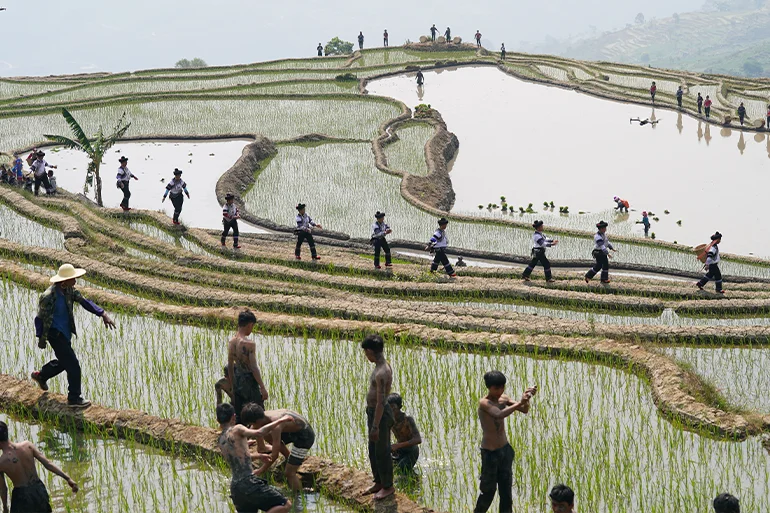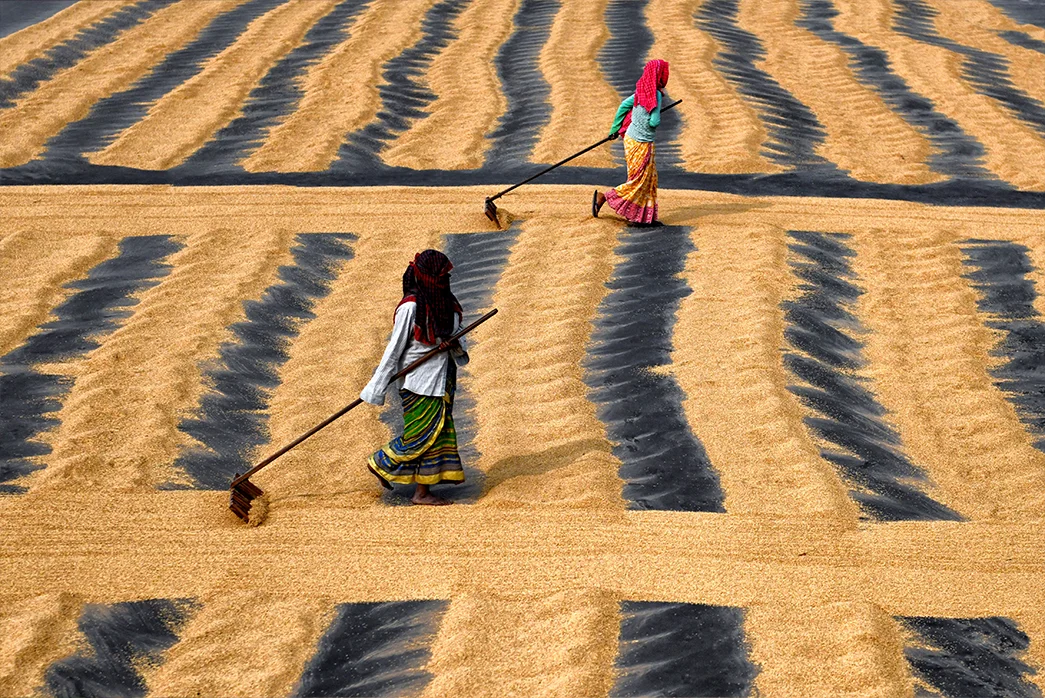Farming for the Future
Bibimbap, Biryani, Jollof Rice, Nasi Lemak, Paella, Risotto, Sushi – the list of delicious rice dishes from around the world is truly endless. But how did this humble grain become a ubiquitous, universally loved food? Let’s look at the origins of rice and scientific innovation that made rice one of the most produced grains on the planet.
How did rice become a global commodity?
Rice, both as a food crop and a commodity, has been instrumental in shaping the early-modern world economy. Once an ancient staple synonymous with Asia and its prosperity, rice now holds a story deeply intertwined with the rise of industrial capitalism and global trade. Roughly four to five centuries ago, the cultivation and trade of rice were largely confined to Asia, where it was grown primarily for subsistence. Any surplus production was typically traded within the continent, often reaching neighboring regions in times of need. Historical records from as early as the 8th century reveal evidence of international rice trade between South Asia and Eastern Africa, highlighting the crop's gradual integration into broader commercial networks.
Around 1,300 years ago, the Hani people in what is now Honghe County, China, developed an intricate system to channel water from mountaintops to their rice terraces. Today, they honor this tradition with the "Kaiyangmen" festival, celebrating through song and dance to pray for a bountiful harvest and good fortune in the coming year. (Photo by Liu Ranyang via Getty Images)
In Europe, rice initially made its way from Syria, Persia, and India, introduced by the Greeks and Romans. However, it was not the staple food we know today but rather a rare medicinal ingredient used to address digestive issues. During this era, international trade primarily revolved around luxury goods such as spices, printed cotton, silks, and porcelain, with subsistence crops like rice being traded only on a limited scale. Consequently, rice had yet to establish itself as a staple in European diets.
Despite this, European traders observed the thriving rice agriculture in Asia and sought to cultivate it themselves. Through the colonization of the Americas, European powers began to realize this ambition. By the 18th and 19th centuries, rice cultivation became a significant driver of colonial expansion into regions like Burma, Brazil, Carolina, and Indochina. Rice grown in these colonies was both traded globally and consumed domestically in Europe. Meanwhile, imperial powers such as China, Mughal India, and Meiji Japan also invested heavily in expanding their rice production to maintain competitiveness in the burgeoning global market.
The subsequent decades were marked by colonial expansion, two World Wars, and political revolutions that eventually led to decolonization. These transformative events reshaped the dynamics of rice cultivation and trade, shifting the balance of power among dominant players. Despite these changes, rice has remained a critical staple food and a valuable trading commodity since the 18th century, underpinning economies and cultures worldwide.
Workers dry paddy grains by creating long columns of rice before spreading the piles with feet and rakes. By reducing the moisture level of the grain, the risk of bacteria is kept to a minimum. (Photo by Avishek Das via Getty Images)
Has science changed rice over the years?
Science has undoubtedly transformed rice, and many of these transformations have been profoundly beneficial. Prior to the end of World War II, advancements in rice cultivation were primarily focused on selective breeding—essentially our ancestors' version of genetic modification, where desirable traits in plants were cultivated over generations—and refining farming techniques.
However, following World War II, the urgent need to address severe famine and rapid population growth in Asia led to international efforts to accelerate improvements in rice production. These efforts included the use of synthetic fertilizers and pesticides, the introduction of agricultural mechanization, and the application of biotechnology. Through these innovations, science has played a crucial role in meeting the demands of a world increasingly reliant on rice. Below are some key ways in which science has helped to nourish a rice-dependent global population.:
Higher yield
Conventionally, early rice crop varieties had a tall and weak stem with considerable foliage. Once harvested, the biomass contained 30 percent grain and 70 percent straw. Since straw cannot be used for human consumption, foliage from the rice plant is either used as a lower-quality animal feed or disposed of as waste. Until the 1950s, rice breeders focused on improving the amount of rice a single plant could produce. When Chinese breeders successfully engineered the first ever semi-dwarf rice variety ‘Guang Chang Ai’ in 1959, it was considered a breakthrough in the field.
Disease resistance
In rice-cultivating regions, the warm, humid, and nutrient-rich conditions create an ideal environment for the proliferation of various plant diseases. These diseases, triggered by a range of pathogens—such as bacteria, viruses, and other microorganisms—as well as insect pests, significantly diminish the yield of semi-dwarf rice varieties, resulting in substantial economic losses for rice-producing countries.
As noted by Siddiq and Vemireddy in their 2021 overview of "Advances in Genetics and Breeding of Rice," pests like the yellow stem borer and brown plant hopper, along with diseases such as blast and bacterial leaf blight, have long posed serious threats to rice agriculture. To combat these challenges, plant breeders have developed rice varieties with enhanced resistance to these pests and diseases, offering much-needed support to rice farmers and helping to safeguard crop yields..
Grain quality
Consumers in different parts of the world have different preferences regarding the qualities they desire in their rice. Some prefer long, slender grains that retain their structure after cooking. Others enjoy short-grained rice that turns sticky after cooking. By employing advanced plant breeding techniques that allow for improving, reducing and even omitting various traits, scientists have enhanced desired characteristics in rice and removed or toned down undesirable taste or texture traits, such as chalky and brittle grains. These modifications have helped rice-producing countries price their rice competitively in the global market.
Nutrient enrichment
Rice serves as a critical source of calories, providing 50 percent of the dietary energy supply for the population in Asia—a continent where malnutrition remains a significant challenge. Following the success of high-yield rice varieties, research efforts have shifted toward developing strains that offer improved nutritional value to consumers. Over the years, breeding programs have focused on enhancing rice with higher levels of essential nutrients, such as protein—large molecules that act as both the building blocks of life and the tools for creating them—and vital micronutrients like iron, zinc, and vitamin A.
In 2017, scientists achieved a breakthrough by using CRISPR technology—a gene-editing tool inspired by the bacterial immune system, which recognizes and neutralizes threats efficiently—to develop a variety of rice enriched with protein. Earlier, in 2000, another milestone was reached with the creation of "Golden Rice," a beta-carotene-rich strain engineered to provide health benefits, particularly in addressing vitamin A deficiency. These advancements highlight the potential of modern science to enhance rice not only as a staple food but also as a vehicle for better nutrition.
Will we continue eating rice in the future?
The short answer is yes, most likely. Rice is a staple food for close to half of the world’s population, making it an indispensable part of many Asian, African, South American, and even European cultures. However, despite all past and present biotechnological innovations, it is not immune to climate change. In fact, rice grows in some of the most vulnerable parts of the world to climate change and faces increasingly serious threats from flooding, rising salinity of soil and water, and heat stress. Current rice cultivation practices are extremely water-intensive and produce higher greenhouse gas emissions than any other crop. To tackle both issues, breeders are working towards developing rice varieties that require less water to grow and at the same time are more immune to flooding and high temperatures. Developing better tillage practices, efficient fertilizers, and using methane-ingesting bacteria are likely to help as well.
About author
SS Engineers and Consultants is a premier engineering firm specializing in innovative design solutions, sustainable practices, and comprehensive project management. With decades of combined experience across various industries, their team of expert engineers and consultants delivers tailored services that meet the unique needs of each client, ensuring safety, efficiency, and cost-effectiveness in every project.
This line emphasizes their professionalism, expertise, and commitment to delivering high-quality results. If necessary, adjustments can be made based on specific areas of focus or achievements!








Comments
Post a Comment